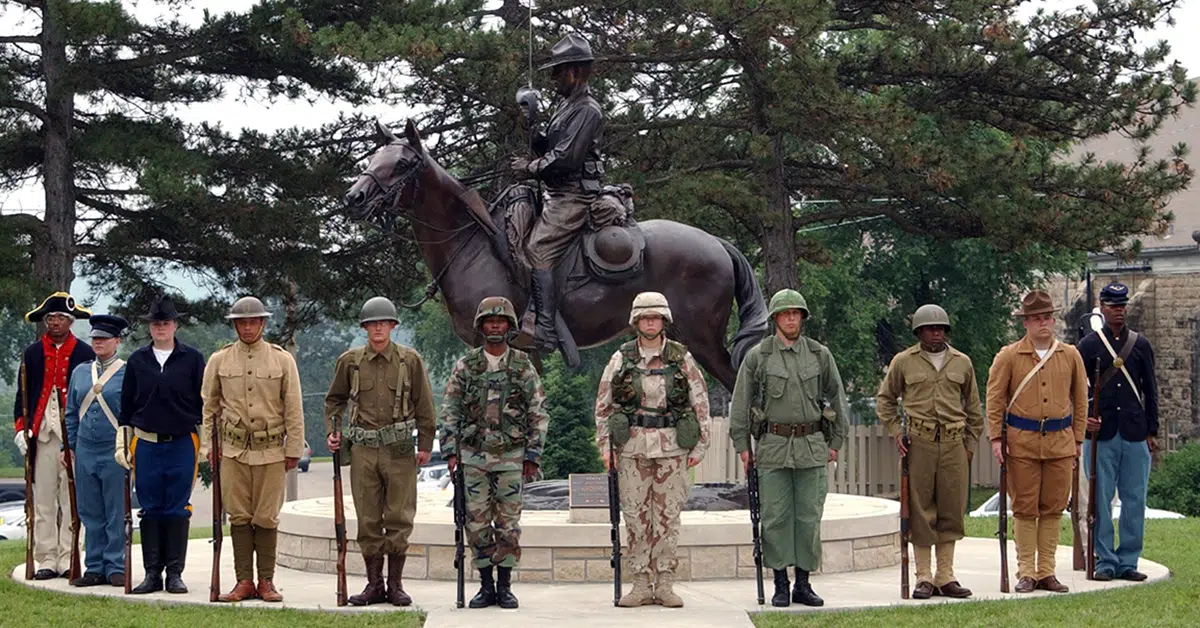The U.S. Army celebrates the 246th anniversary of its founding on June 14. On that day in 1775 (a year before the signing of the Declaration of Independence) the Second Continental Congress passed a resolution that read:
Resolved, That six companies of expert riflemen, be immediately raised in Pennsylvania, two in Maryland, and two in Virginia… [and] as soon as completed, shall march and join the army near Boston, to be there employed as light infantry, under the command of the chief Officer in that army.
Up until that day, the colonial revolutionaries had relied on civilian militias to fight the British, each colony contributing its own force to the effort. But with the creation of the Continental Army, placed under the leadership of George Washington, the fledgling nation’s forces reached a new level of sophistication.
The Continental Army was crucial in securing the victory that led to the founding of the United States of America. But despite this success, the Army was disbanded after the War of Independence. Having just waged war against a professional army, Americans distrusted the idea of a national army for their own country, preferring to rely on state militias instead.
New Century, New Approach
America’s “as-needed” approach to defense was challenged during the War of 1812. At the time, the U.S. had only a small Regular Army, preferring to rely on state militias, which would be raised and disbanded as needed. But this ad hoc approach almost cost the U.S. its independence during its second major conflict with Britain.
Organizing militia volunteers was a slow and inefficient process. And most militia members weren’t well trained. This lack of expertise allowed the British to burn down the new capitol in Washington, D.C., and gave Britain a clear advantage in the war. The shocking loss of Washington prompted Congress to increase its efforts to grow the Regular Army. With additional forces, the U.S. did manage to eke out a victory, but the Army never reached the size the nation’s leaders wanted. Because of this, some historians argue that luck, as much as military might, played a large role in America’s eventual victory in this conflict.
Modern Times Require a Modern Army
After the War of 1812, the nation’s leaders recognized the need for a better-organized military. Congress acted soon after to support the growth of a national Army, one that had strict training protocols and career soldiers.
This was the Army that served so well in both World Wars. In World War I, more than four million Army “doughboys” helped ensure the Allied victory, facing machine guns, tanks, and airplanes in one of the first recognizably modern conflicts. And two decades later, the U.S. Army proved its mettle once again in World War II, when more than 8 million troops fought bravely overseas and proved decisive in this second victory for the Allies.
Today’s all-volunteer Army proudly continues these traditions, even as it has grown more technologically sophisticated. The Army has also expanded its humanitarian missions over the past few decades, frequently dispatching troops to help after natural disasters both at home and abroad. From evacuating civilians from dangerous situations to providing critical medical aid, Army personnel provide lifesaving services throughout the world.
PRIDE Industries and the US Army
Since 2007, PRIDE Industries has been supporting Army installations across the country, including Fort Rucker, Fort Polk, Fort Bliss, Fort Campbell, Fort Dix, and Fort Gillam. Our carefully vetted and highly trained employees provide a full range of facilities services, including HVAC, plumbing, electrical, and carpentry work. We also perform landscaping and custodial services.
From roof repair to road repaving, our services help the Army stay mission ready. Our work teams take pride in being able to meet any request, no matter how unusual. They have rebuilt walking paths, installed backup generators, and even managed the aircraft arresting barriers at a major Army installation.
More than 800 PRIDE Industries employees currently perform work for the U.S. Army. In keeping with our mission to provide employment opportunities for people with disabilities, nearly 500 of these workers have a disclosed disability. And across all the military installations we serve, roughly 20% of our employees are military veterans, a group that PRIDE Industries supports through specialized job training, recruitment, and placement services.
The Military Skills Translator and Other Services
PRIDE Industries is fortunate to employ many Army veterans, along with dozens of veterans from other branches of the military. During the past fifty years, we’ve helped thousands of people find meaningful employment after retirement from service.
To help soldiers find their place outside the barracks, PRIDE Industries offers an online tool designed specifically for veterans: the Military Skills Translator. With the Military Skills Translator, veterans can easily determine which civilian jobs best correspond to the valuable experience they gained while serving our country.
At PRIDE Industries, we know that the training military personnel receive while serving our country makes them valuable employees once they return to civilian life. And ours is not the only company to recognize the benefits of hiring veterans. That’s why PRIDE Industries does more than offer direct employment to veterans. We also help companies across the U.S. find these sought-after employees through our Inclusive Talent Solutions (ITS) initiative.
Innovations like ITS and the Military Skills Translator, along with the many employment services we offer veterans, are why PRIDE Industries has been recognized as a top employer of military veterans. If you or a veteran you know is ready for a new career, contact PRIDE Industries today.
